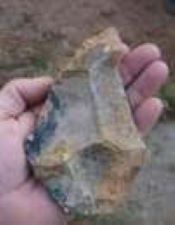A surprising find of a prehistoric remain at the Islamic necropolis in Tauste
A flint has been found during diggings at the Muslim cemetery

Archaeologists and anthropologists have found bones of 10 adult skeletons during the first days of the excavations.
Excavation works at the local Muslim necropolis started last Monday, 1 July 2013. Its fourth phase includes diggings on the site at Obispo Jose Maria Conget Avenue, 74 and is going to be conducted throughout July.
A team of volunteers of the University of Zaragoza specializing in archaeology and anthropology has been working on these excavations promoted by the El Patiaz Cultural Association under the supervision of the archaeologist Francisco Javier Guitierrez Gonzalez and consulting of the Professor of Medieval History of this University, Carlos Laliena Corbera.

During the first days, the layer of concrete was removed and a gypsum pavement was found. Buried 40 centimeters underground it was covered with a thin layer of graded aggregate.
The pavement was a part of recent construction that existed until the mid-20th century, when this area was used to keep grain threshing floors. Right under the layer of graded aggregate, just as expected, we found human remains.
From the very start, it became obvious these would date back to the days of the Islamic rule in Tauste (714 – 1121), given that the features of the tombs were impossible to confuse – all bodies were placed on their side facing Mecca.
On the fourth day of the excavations, the human remains of ten adults were found in different stages of preservation. This was due to their close location to the above-mentioned gypsum pavement, which partially crushed them.
A Paleolithic flint
While removing the layer of graded-aggregate, a surprising find was made: a carved flint tool dating back to the Middle Paleolithic and used by Neanderthals (150,000 to 30,000 BCE).
It is not the first time such piece is found. Last March, a Mousterian stone point, also carved, was uncovered. It comes from the same municipal quarry from which the graded aggregate has been extracted for decades. This quarry is located six kilometers away from the city center, between the road from Tauste to Ejea and the river Arba.
2013 work field goals
In the moment of crisis and scarcity of financial resources, the will and effort of the El Patiaz Cultural Association to promote and research the historical and cultural heritage have been decisive for setting in motion this summer work field. In it, students and volunteers have a chance to learn and practice while actively participating in the research on this significant site: one of the oldest necropolises in Spain that according to the carbon-14 method dates back to the 8th century (the oldest Islamic tomb recorded in Aragon).
This site is deemed highly important and priceless as it can change our understanding of history regarding the Muslim presence in Tauste. So far, such presence has been considered purely incidental. The find of this cemetery, however, comes to prove the existence of a steady and settled population in this area.
The archaeologist Francisco Gutierrez estimates this necropolis may contain around 4,500 tombs; besides, the fact that it has two levels indicates its large surface and long occupation period.
Three more weeks of archaeological excavations are left. After that, the anthropolgist Miriam Pina will conduct an anthropological analysis of the uncovered human remains. She is to do a basic study of the bodies, identify their age, height and sex, and also conduct a paleopathological analysis of the remains.
During the third round of the trial excavations, such analysis led to a significant find of trepanation on one of the skulls uncovered. This surgical or ritual technique implies drilling holes in the skull with lithium or metal tools (less and less frequent in the medieval period). Bone regeneration suggests that the person survived the trepanation.
Visits to the site
During the first week, when the excavation site of the Islamic necropolis in Tauste was open to visitors, it received various groups willing to see the progress of the works in question. The visitors arrived from Orense, Ciudad Real, Madrid and, of course, Zaragoza, according to the data provided by Tourism Manager, Francisco Castillo. Groups of Tauste dwellers have also approached the excavation site to see the remains uncovered so far.
While the excavations are being conducted, guided visits will be available for the public interested in seeing the tombs that are now open on the site.
Those who want to come can contact the Tauste Tourist Office located in the Camara Building (Cuesta de la Cámara, 10). Telephone number 660 78 94 31, email: turismotauste@gmail.com
In the picture, you can see a group of visitors led by the tourist guide Francisco Castillo. On the left: the artist Fermin Ledesma, Professor of Art and Painting at the People’s University of Zaragoza and the architect Jose Miguel Pinilla, one of the promoters of the Zagri-theory are talking to the Professor of Medieval History of the University of Zaragoza Carlos Laliena and the excavation director Francisco Javier Gutierrez along with Jaime Carbonel, from El Patiaz, during their visit to the maqbara in Tauste.
Crowdfunding campaign
Due to the lack of financial support from public institutions, the El Patiaz Cultural Association launched a micro-donations campaign to raise funds and preserve interest in one of the most relevant research in the history of Tauste.
Individual donations to finance this project can still be made on the bank account of the Association, Bantierra No. 31931 0215 12 4117981417.
It can also be made by safe payment via PayPal using the following form:

j.a.
Acknowledgement

The translation of this page is included in the Zaragoza Provincial Council Grants for the Dissemination and Revitalisation of Cultural Heritage in the year 2022.
La traducción de está página esta incluida dentro de las Ayudas de la Diputación Provincial de Zaragoza para la Difusión y Dinamización del Patrimonio Cultural en el año 2022.




